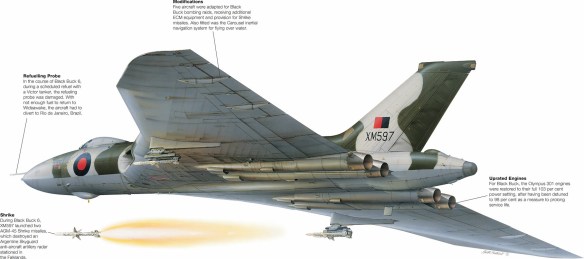Vulcan B.Mk 2 XM597, stationed at Wideawake Airfield, Ascension Island, during the Falklands campaign of 1982. This aircraft was used on both Black Buck anti-radar attacks and made an emergency landing in Brazil after a raid on the night of 2/3 June.
Vulcan B.Mk 2 XM607 was one of the aircraft involved in the first of the Black Buck raids against Port Stanley airfield, flown on 1 May 1982, and armed with 21 1000lb (454kg) bombs.
Most successful of Britain’s three V-bombers, the Vulcan enjoyed an impressively long service career, starting out as a high-level strategic nuclear bomber and later going into combat as a conventional bomber during the Falklands campaign.
The Vulcan was one of the results of the United Kingdom’s Specification B.14/46, which called for a bomber capable of striking a target at a range of 2735km (1700 miles) carrying a nuclear weapon weighing 4536kg (10,000lb), and offering a cruising altitude of 12,190m (40,000ft) and a full-load range of 6437km (4000 miles). This specification was later revised to become B.35/46, which led to the development of the three V-bombers: the Avro Vulcan, the Handley Page Victor and the Vickers Valiant.
In its initial prototype guise, the Vulcan employed a wing planform that was an almost perfect triangle. In this distinctive form, the aircraft completed its maiden flight in August 1952, and was flown with Rolls-Royce Avon, Armstrong Siddeley Sapphire and finally Rolls-Royce Conway engines. Since the delta wing marked a new departure, a series of Type 707 one-third scale research aircraft had been completed beforehand to test the concept. It would be another 30 years after its first flight before the delta-winged bomber first saw combat over the South Atlantic, in what were then the longest bombing raids ever staged.
After completion of two prototypes, the Vulcan B.M 1 entered RAF service in February 1957. This version had a modified wing of 330m2 (3554 sq ft) area with the inboard sections accommodating the four Bristol Olympus 101 engines, each developing 48.93kN (11,000lb) of thrust. Compared to the prototypes, the overall planform of the definitive production aircraft was modified with reduced wing sweep from the root to the mid-point, the result being a kinked leading edge. As production progressed, more powerful Olympus Mk 102 or Mk 104 engines were installed. In 1961, aircraft were modified with electronic countermeasures (ECM) equipment in a modified tailcone, becoming the B.Mk 1A aircraft.
Deliveries of the B.Mk 1 amounted to 45 before production switched to 89 of the much-improved B.Mk 2 variant. The Mk 2 was entirely re-engineered and its most prominent feature was a much larger but thinner wing, with cranked and cambered leading edge, housing more powerful Olympus engines. Other changes included elevons replacing the B.Mk 1’s ailerons and elevators, and an inflight refuelling probe. The Vulcan B.Mk 2 entered service in July 1960 and was initially employed in a high-altitude role. The definitive Vulcan B.Mk 2A added the capability to carry a single Blue Steel standoff missile. As the final B.Mk 2 was delivered, almost all the remaining B.Mk 1s had been withdrawn from use.
In 1966 the Blue Steel was also withdrawn from service as the appearance of new surface-to-air missiles prompted a switch to low-level operations, for which a terrain-following radar was added in a nose fairing. At the same time, the ECM fit was appropriately upgraded. In 1962 the B.Mk 2 was re-engined with 88.96kN (20,000lb) Olympus 301 engines. Total production of the B.Mk 2 amounted to 89 aircraft, for a grand total of 134 Vulcans of both marks.
In the early 1980s it became apparent that the Vulcan’s fatigue life was running low, as a result of the low-level focus. However, it was decided that the cost of extending the service life of the remaining aircraft was too great. It was decided to withdraw the Vulcan force between June 1981 and June 1982.
Falkland Islands Swansong
The Vulcan force was mid-way through being wound down when, in April 1982, Argentine forces invaded the Falklands in the South Atlantic. By now the Vulcan had lost its inflight refuelling capability, and a search was begun for refuelling probes with which to equip the remaining bombers, in order to stage an attack on the Falklands from Ascension Island. Six aircraft were converted as Vulcan K.Mk 2 tankers, with a hose and drogue unit in the rear ECM bay and extra fuel in the bomb bay, while others were equipped for the carriage of conventional bombs, new navigation systems, refuelling probes and underwing pylons for AN/ALQ-101 electronic countermeasures pods and AGM-45 Shrike anti-radar missiles.
In the course of round trips exceeding 12,870km (8000 miles), and under the codename Black Buck, the Vulcans bombed the occupied Port Stanley airfield and related radar installations in the Falklands, putting the runway out of action. The last Vulcans to bow out of service were the K.Mk 2 tankers, finally retired in March 1984.
Maritime Operations
Towards the end of the type’s career, nine aircraft were modified for the Strategic Maritime Radar Reconnaissance (MRR role) as Vulcan B.Mk 2MRR aircraft. Conversions were made in 1973 and the aircraft were outfitted with an array of classified electronic, optical and other sensors, as well as additional fuel in the bomb bay. The aircraft were operated by RAF Scampton-based No.27 Squadron from November 1973 to May 1982, assuming the role from Victor B.Mk 2(SR) aircraft of No.543 Squadron that were in turn converted as inflight refuelling tankers. Compared to the standard Vulcan bomber, the B.Mk 2MRR received LORAN-C navigation equipment and the terrain-following radar thimble was removed from the nose. Air-sampling pods could be fitted below the wings for testing the air for contamination, such as dust from nuclear tests.
